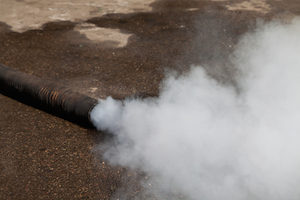 Carbon monoxide is an odorless, tasteless, colorless gas that is commonly referred to as the Silent Killer. The Centers for Disease Control and Prevention estimate that approximately 500 people die per year in the United States because of carbon monoxide poisoning and 15,000 individuals are treated in the hospital for injuries related to carbon monoxide poisoning.
Carbon monoxide is an odorless, tasteless, colorless gas that is commonly referred to as the Silent Killer. The Centers for Disease Control and Prevention estimate that approximately 500 people die per year in the United States because of carbon monoxide poisoning and 15,000 individuals are treated in the hospital for injuries related to carbon monoxide poisoning.
Carbon monoxide is especially dangerous because it makes it difficult for people to know when they have been exposed. Its dangers are enhanced by the fact that its symptoms – particularly headaches and dizziness – can make a victim believe he has a much less serious ailment. People may not get help initially, because they do not think anything is wrong with them; they may visit a doctor and be improperly diagnosed. A lack of treatment can make carbon monoxide injuries worse, because the body is deprived of oxygen for a longer period of time.
Carbon monoxide poisoning results from inhaling carbon monoxide. The carbon monoxide will bind with the hemoglobin in a victim’s red blood cells with 240 times the affinity of oxygen, displacing oxygen in the blood; when oxygen is displaced, it cannot be delivered to the heart, brain or other organs, causing many health problems.
Chronic exposure to low levels of carbon monoxide can cause depression, memory loss or confusion. The symptoms of carbon monoxide poisoning include:
– Confusion
– Headache
– Vomiting
– Fainting
– Flu-like symptoms
– Impaired judgment
– Coma
– Death.
The symptoms of carbon monoxide poisoning should be addressed immediately. A lack of decisive action during the early stages of carbon monoxide poisoning can compound the problem. The most important treatment is to remove yourself from the source and neutralize the effects of the carbon monoxide with high doses of oxygen. If the poisoning occurs at home, and the source of the carbon monoxide is unknown, immediately leave the home and contact the local fire department or public service company to inspect and neutralize the problem before you return home. Many of the effects of carbon monoxide outlive the length of exposure and can be permanent.
Exposure to carbon monoxide should be avoided. However, sometimes avoiding it is not possible. If you are exposed through someone else’s negligence, you may wish to file a civil lawsuit to recover for damages or wrongful death. Examples of such a situation would be a landlord failing to take reasonable care; use of portable generators while camping or hunting; or a heating or air condition system which was improperly installed.
If you or a family member has been the victim of carbon monoxide poisoning, it is important that you understand what options you have for compensation. The lawyers of Wolff Ardis, P.C. can help you determine what steps you should take to protect your rights, including pursuing a case against a product manufacturer, a landlord, a construction company, or others. There are certain legal requirements that must be met to prove your claim and receive compensation. The lawyers of Wolff Ardis, P.C. can help you gather the evidence you need in order to recover what you deserve.







